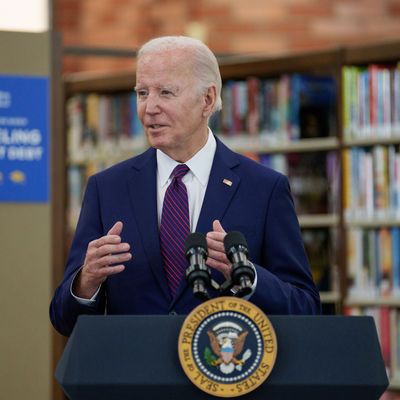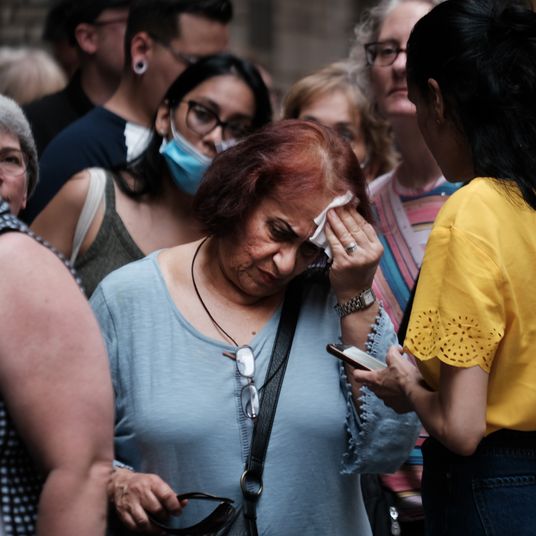
More than 43 million Americans — one in five adults — collectively owe more than $1.7 trillion in federal and private student loans. In recent years, the idea of the government forgiving federal student debt went from fringe to mainstream with both Donald Trump and Joe Biden using emergency powers during the pandemic and after to ease the financial burden on college graduates, whether in their 20s or 70s. But sorting through the tangle of options, acronyms, requirements, and deadlines for lowering a crippling balance or potentially wiping it clean has become increasingly painful. Successfully navigating through yet another round of new steps in the loan-forgiveness labyrinth could mean the difference between two starkly different outcomes.
Do it right and you can wind up with manageable, if not zeroed out, monthly payments that free up cash and make your daily financial life far more pleasant. Mess it up and you face the financial equivalent of an ineradicable pantry moth that gnaws away at your long-term savings and a longer-term credit-score blemish that will, among other things, raise the costs of home-buying. Forgiveness generally applies only to loans funded by the federal government, not to private ones made by banks, state agencies, and schools. Still, nearly 93 percent of all student debt, or $1.6 trillion, is federal, so even if you’re exhausted by the options, locking down on the government’s opportunities now unfolding, if you can, is essential. And one of the programs has a new (extended) June 30 application deadline. Here’s what you should know.
.
A quick history of Biden’s efforts to forgive student debt
For the fourth consecutive year, borrowers ranging from recent college graduates in the workforce to late-career professionals to even retirees have endured whiplash over whether their often crippling debt will be a lifelong ball and chain. In March 2020, President Trump paused loan repayments and interest as the pandemic shuttered the economy. After several extensions under the Biden administration, interest restarted last September and payments resumed for all but the most recent graduates one month later. Borrowers who haven’t been making payments since last October are protected through a September 30 “on-ramp” from having their delinquency reported to credit agencies.
Still, the resumption hasn’t gone well. The Consumer Financial Protection Bureau said in January that borrowers faced long hold times when calling their loan servicer, “significant delays” in processing their applications for income-driven repayment plans, and “inaccurate billing statements.” A survey of 17,000 borrowers by the nonprofit Student Debt Crisis Center released on March 5 found that three in four borrowers were not confident that the information provided by their servicer was complete and accurate.
In August 2022, President Biden announced a sweeping executive action authorizing the Education Department to forgive nearly $400 billion in loans, up to $20,000 per borrower. In June 2023, the Supreme Court struck down the plan, ruling that it violated a 2003 law known as the HEROES Act.
The setback from the nation’s highest court prompted Biden to shift to what’s called his plan B.
.
Biden’s newest student-loan-forgiveness proposal
On April 8, Biden announced a sweeping new student-loan-forgiveness plan that aims to help roughly 30 million Americans. This time around, the plan relies on a different law — the Higher Education Act — than the plan that was struck down by the Supreme Court.
The plan, if successful, would offer various forms of relief to five groups of Americans:
Borrowers whose loan balance, because of interest, has exceeded the amount that they were initially loaned
The new plan would cancel up to $20,000 in interest for 25 million borrowers who are enrolled in an income-driven repayment plan and now owe more than what they originally borrowed because of runaway interest. For individual borrowers who make up to $120,000 or families earning $240,000 or less, the plan would erase all of their interest, without the $20,000 maximum limit.
Borrowers who have been in repayment for more than 20 years
Biden’s new plan aims to automatically cancel the undergraduate debt of anyone who has been repaying their loans for 20 years (since July 1, 2005) and forgive the graduate-school debt of anyone who has been in repayment for 25 years (since July 1, 2000).
Borrowers who attended “low-financial-value programs” like those offered by shady for-profit universities
The new plan would also automatically cancel the debt of Americans who took out student loans to attend colleges that have since been stripped of their certification or barred from taking part in the Federal Student Aid program — making degrees earned at those institutions unmarketable.
Borrowers who already qualify for forgiveness but haven’t yet applied
The plan would automatically cancel the student-loan debt of 2 million low- and middle-income Americans who are already due forgiveness but have yet to apply for it, either because they don’t know about it or have had trouble figuring out how to submit an application.
Borrowers experiencing hardship
The details of this plan haven’t been fully worked out yet, but the idea is to wipe out the student-loan debt of people at risk of defaulting on their loans who are experiencing financial hardships, like high medical or caregiving expenses, that are affecting their ability to pay off their loans. These people may need to apply for that relief, however.
Per the Associated Press, most of the loan cancellation should happen automatically without requiring borrowers to apply for it.
The administration’s plan will not go into effect immediately. The New York Times reports that the new regulations will be subject to a public-comment period for several months and could potentially face legal challenges. This newly proposed loan-forgiveness plan stands alone from the SAVE plan, the new repayment program recently introduced by the administration.
.
The SAVE plan
In the summer of 2023, Biden launched his Saving on a Valuable Education (SAVE) plan, an income-driven repayment (IDR) program that can halve or zero out monthly payments. The plan calculates payments based on a borrower’s income and family size — not on their loan balance — and forgives remaining balances after a certain number of years. Borrowers have to sign up for SAVE unless they were already in the government’s Revised Pay As You Earn (REPAYE) program, in which case they’re automatically enrolled.
Under SAVE, single people earning no more than $32,800 and with no discretionary income see their monthly payment plunge to $0 and get credit for a payment they otherwise would have made — forgiveness in disguise. The same is true for a family of four with an annual income of $67,500. SAVE also forgives any unpaid interest that accrued since your last timely payment. For borrowers earning discretionary income above 225 percent of the federal poverty level (this year, $33,885 for a single person and $70,200 for a family of four), monthly payments are lowered based on that discretionary income, meaning higher earners can also qualify, though the more you make, the less relief you get.
The White House says the typical borrower will see about $12,000 of interest payments waived and upwards of 95 percent of their principal forgiven under the program — a boost that it says creates “sizable potential lifetime wealth benefits.” The typical graduate of a four-year public university will save nearly $2,000 a year.
Last February, SAVE made it possible for people who borrowed no more than $12,000 to see total loan forgiveness in as few as ten years rather than 20 to 25 years. Borrowers with debt above that level see one additional year to forgiveness for each $1,000 borrowed with the maximum time 20 years for undergraduate loans plus another five years for graduate loans. Come July, undergraduate-loan payments under the program drop to 5 percent of discretionary income from 10 percent with payoff within 20 years. Graduate loans fall to 10 percent with payoff in 25 years. Borrowers with both types of loan will pay between 5 to 10 percent of their free income.
On April 12, the Biden administration announced that it was forgiving $7.4 billion worth of student debt for roughly 277,000 borrowers who have been repaying their loans for at least a decade — including $3.6 billion worth of loans for nearly 207,000 borrowers enrolled in the SAVE plan. The administration said it had informed the borrowers via email. And, on May 22, the White House announced an additional $7.7 billion in loan forgiveness with $613 million of that going to borrowers enrolled in the SAVE plan. 5.2 billion stem from through fixes to PSLF whereas $1.9 billion came from changes to IDR payment counts, per the U.S. Department of Education.
It’s also worth noting that, once again, Republicans are attempting to stymie Biden in court. Two groups of Republican attorneys general have filed lawsuits to block the SAVE plan, arguing that the plan is illegal and will harm their states in a variety of ways. One of those lawsuits has already encountered a setback. On June 7, a district judge in Kansas, where that suit was filed, said that three of the 11 states that sued to stop the SAVE plan “just barely” have enough standing to prove that the plan will injure their revenues, and that they have a weaker case than the one that ultimately prevailed at the U.S. Supreme Court in 2023. The judge also said that the other eight states’ argument, that the SAVE plan will undermine their efforts to recruit public servants, won’t hold up in court.
.
What about the new and improved forgiveness program for public servants?
People who work full time for a nonprofit (excluding labor unions and political organizations) or a federal, state, local, or tribal government have additional options under the Public Service Loan Forgiveness (PSLF) program, which erases a borrower’s federal student debt after 120 monthly payments over ten years. The program also covers some teachers, doctors, nurses, firefighters, social workers, U.S. Armed Forces members, and lawyers working for the government, among other low-paying not-for-profit jobs.
The PSLF program has been around since 2007, but was in an administrative quagmire until the Biden administration implemented reforms. Borrowers rejected in earlier years, generally due to the type of repayment plan they are enrolled in, are getting a second look under an Education Department review expected to be completed in July.
As of March 21, 871,000 borrowers have been granted $62.5 billion in relief under PSLF since October 2021. Prior to that, only 7,000 borrowers had ever received forgiveness.
To enroll in PSLF, tell your current loan servicers — either through a phone call or through the government’s PSLF Help Tool — that you plan to apply for PSLF. When using the tool to complete your application, you either choose an IDR or let MOHELA — a Missouri-based company that is the government’s official servicer for PSLF applicants — choose one for you. Loan servicers will transfer your loans to MOHELA.
Even with the Biden administration’s improvements, however, that hasn’t always gone smoothly. The Student Debt Crisis Center has first-person horror stories but also a wealth of helpful links to the various federal programs, along with free web-based workshops, definitions of terms, and helpful Q&A sections. The Education Department, which sanctioned MOHELA last October for sending borrowers delayed or faulty statements, is continuing to monitor the situation.
.
Some borrowers can still apply for a onetime payment adjustment
Under a separate Education Department program, borrowers with federal loans, including privately held FFEL (Federal Family Education), Parent PLUS, Perkins, and HEAL (Health Education Assistance) loans, originally had until April 30 to apply for a onetime payment adjustment — but the Biden administration has since extended the deadline to June 30. This payment adjustment could allow many borrowers to have their entire debt canceled or receive credits that lower their balances. The process involves consolidating your student loans (borrowers typically have multiple loans) into one bunch, then enrolling in a government-run income-driven repayment plan, such as SAVE.
If you are already in an income-driven repayment program but haven’t yet consolidated, or are seeking PSLF, you have until June 30 to consolidate your loans and have any IDR or PSLF payments you previously made count toward forgiveness. That’s known as a “payment count adjustment” — and it will allow more than 3.6 million people who borrowed through the popular William D. Ford Federal Direct Loan Program to receive at least three years of credit toward loan forgiveness. Many borrowers will see their loans forgiven automatically. But if you miss the June 30 deadline, your payment count towards forgiveness resets to zero once you get a new consolidated loan, meaning you’ll be paying off a higher amount, likely over a longer period of time.
The first step, if you haven’t already, is to gather your loan details — type, servicer, loan amount, and interest amount — and set up a Federal Student Aid account. You’ll need that account to complete your application. And if you don’t know who your loan servicer is, logging into the account will tell you those details.
Here’s what will happen if you consolidate your student loans: Your monthly payment may decrease, but you may have to pay over a longer period of time, which could mean an increase in the total loan-lifetime interest you pay overall. If you have unpaid interest, your consolidated principal balance will include that interest and go up. And the new consolidation loan will typically carry a new interest rate. Studentaid.gov has put together a helpful guide to the various implications. By the way, the consolidation itself is free — there are no annoying fees to worry about.
To get started, go over to the government’s student loan consolidation website and click “Log in to Apply” on the upper right of the screen. The government says, mercifully, that the entire application process for a consolidation loan typically takes less than 30 minutes and doesn’t have to be done in one go — you can save your draft application and come back to it later.
During the process, a prompt on the website will ask you to choose an income-driven repayment plan for your Direct Consolidation loan. Here’s where things get a bit more complicated. Which plan to choose depends on a host of factors, including projected income, family size, and whether you’re including a spouse’s student loans in the consolidation. A helpful and easy-to-use loan simulator lets you plug in your broader financial data, including employment status, health insurance premiums, and tax-deferred retirement savings — if you have a 401(k) or traditional individual retirement account — and compare the options. The government recognizes that life takes twists and turns and thus lets you change repayment plans at any time at no cost.
Consolidation loans are typically disbursed in roughly 60 days but sometimes take longer.
Sorting all this out can feel overwhelming, but there’s really only one downside. Borrowers who come out free and clear of student debt can find their creditworthiness dented: Somewhat perversely, a closed installment loan, like a student loan, is no longer a line of credit by which on-time payments can boost your score. But at least you’d be free and clear of student debt.
This post has been updated.





























